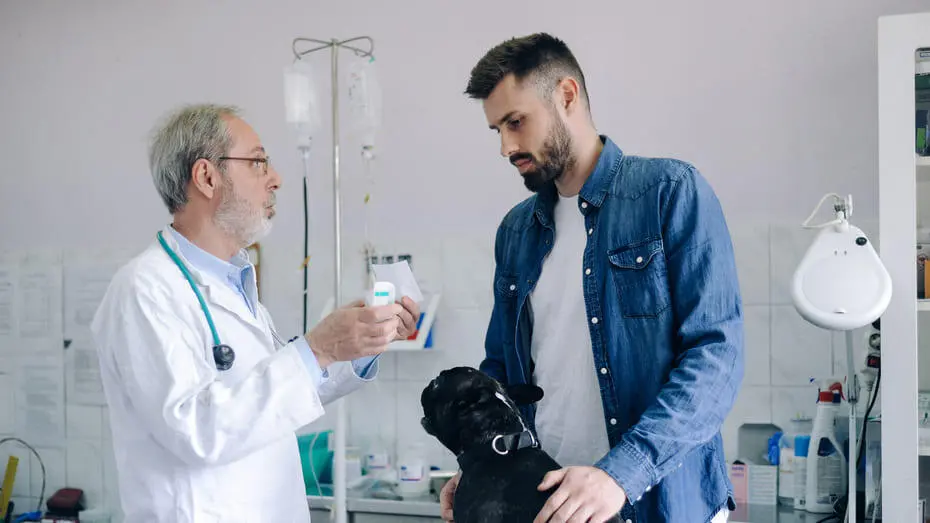When a dog develops mastitis, what exactly are we talking about?

Infected mammary glands are known as “mastitis” in dogs. Female dogs are more likely to get it during feeding, however, it may also develop after a miscarriage. Usually, a bacterial infection is to blame.
Dogs seldom get mastitis, but if it goes untreated, it might be fatal. Knowing the signs of mastitis in dogs can help you diagnose the condition early and begin treatment without delay.
This article will discuss canine mastitis, including its causes, symptoms, and treatment options. Researching mastitis can help you recognize the signs and treat your dog promptly if she is pregnant or has just given birth.
When a dog develops mastitis, what exactly are we talking about?
When the mammary glands of a dog become inflamed, it is referred to as mastitis. While bacterial infections are the most common cause of mastitis, fungal infections are also possible triggers. Female dogs are more likely to have this condition while they are nursing a litter of pups, although it is not limited to that population.
An infected dog’s mammary glands may enlarge and cause severe discomfort. It is important to keep nursing pups away from the teats of a dog that has mastitis since the milk is poisonous to them.
Mastitis may affect a single gland or many glands at once. A dog’s susceptibility to mastitis may be increased by living in unclean surroundings, experiencing stress from having puppies, or having a systemic illness.
In terms of its duration and severity, mastitis may be either acute (developing abruptly and lasting just a few days) or chronic (lasting a long time and gradually becoming worse). From a localized infection in one gland to a life-threatening abscess or even a catastrophic systemic sickness, this condition may rapidly worsen. Since this is the case, it is critical to take your dog to the doctor as soon as you see any signs of mastitis. Your dog has a higher chance of making a full recovery if treatment begins right away.
How Do You Recognize If Your Dog Has Mastitis?
 Canine mastitis symptoms range from mild to severe, and from early to late stages. When mastitis is moderate, the first symptom is often a slowdown in the rate of weight growth by the nursing pups. Because of this, the mother may only feel minor pain and not display any symptoms of mastitis.
Canine mastitis symptoms range from mild to severe, and from early to late stages. When mastitis is moderate, the first symptom is often a slowdown in the rate of weight growth by the nursing pups. Because of this, the mother may only feel minor pain and not display any symptoms of mastitis.
You should keep a watchful check on your dog if it is nursing since mastitis in dogs may rapidly worsen and cause more noticeable and severe symptoms. There are more signs of mastitis in dogs, such as:
- Depression or dog lethargy
- Decreased appetite
- Anorexia
- Fever
- Dehydration
- Reluctance to nurse puppies or discomfort when nursing
- Puppies are failing to thrive
- Hot, firm, and swollen breast tissue
- Teats are bruised or purplish-blue
- Milk from affected glands appears thin, cream-colored, watery, or bloody
- Abscess on the affected glands
A dog with mastitis will show more signs of illness as the infection progresses. Shaking, weakness, panting, and low blood pressure is among symptoms of septic shock that may appear in affected dogs. When an illness first enters a dog’s bloodstream, it might cause vomiting. Taking your dog to the doctor as soon as you see the first indications of mammary gland enlargement and poor puppy development will help avert this problem.
For what reasons do some canine females get mastitis?
To put it simply, a bacterial infection in the dog’s mammary glands is what causes most cases of mastitis. Escherichia coli (E. coli), Staphylococci, and -hemolytic Streptococci are the most prevalent bacteria that will cause this illness. Bacteria may enter the mammary glands via a few different entry points, including:
- An infection up the teat canal from the skin
- Trauma to the nipple, teat canal, or mammary glands caused by puppies’ nursing
- Poor sanitary conditions
- The spread of a system infection that’s occurring elsewhere in the body
- Extended periods of time of milk accumulation in the mammary glands without removal. This can result from the sudden weaning of puppies
There is a chance that mastitis occurs in a dog even if they aren’t pregnant or nursing. In this case, it may be caused by cancer of the mammary glands, which would require immediate medical attention from a vet.
How Do Veterinarians Identify Mastitis in Canines?
Take your dog to the doctor immediately if you see any of the signs of mastitis listed above. The only way a vet can make an accurate diagnosis is by doing a full physical examination. They may also order certain lab tests to double-check their findings and rule out other potential causes.
Milk engorgement of the glands without infection is called galactostasis, and an examination will tell you whether your dog has galactostasis or mastitis. A veterinarian will be able to narrow down the possible diagnoses based on the severity of the patient’s symptoms.
A veterinarian may do any of the following laboratory tests:
- Blood cell count: A blood cell count test will assess the levels of red blood cells, white blood cells, and platelets in your dog’s blood. Any changes in the white blood cell count can help a vet determine the severity of the infection.
- Bacterial culture: A bacterial culture will be performed if a bacterial infection is present or if the infection isn’t responding well to an antibiotic. In a bacterial culture, milk will be collected from the mammary glands and sent to a lab so that the bacteria can be further examined. Antibiotic sensitivity testing will then be done to figure out the best antibiotic for treatment.
- Milk cytology: In milk cytology, a small amount of milk will be taken from the affected mammary gland and examined under a microscope. If white blood cells or bacteria are present, then a diagnosis of mastitis will be confirmed.
Dog Mastitis Treatment Options

If untreated, mastitis may be fatal to the breastfeeding mother. The good news is that mastitis in dogs is usually treatable if found early. Mastitis in dogs may be treated in a number of different ways, but the best course of action will change based on the dog’s examination and test findings. It’s probable that a number of different therapies may be suggested.
In most cases, antibiotics will be necessary to treat the bacterial infection, however, the specific antibiotic needed may vary depending on the bacteria causing the illness. Depending on the severity of the signs and symptoms, a doctor may also recommend pain medication.
Mild cases of mastitis in dogs usually respond well to home care. The mother may rest comfortably in the company of her offspring. The pups may be able to continue nursing if the illness is minor; however, your veterinarian may advise that you manually milk the afflicted gland to reduce pain, eliminate the infection, and speed recovery. It’s recommended to milk by hand every six hours.
If the pups insist on nursing, keep a watchful eye out for any changes in their appetite, activity level, or feces. If the mother is taking an antibiotic, it might be passed on to her pups via breast milk, therefore it’s important to be careful while making your selection.
The soreness and swelling in your dog’s mammary glands may be alleviated by placing a warm compress on them or by covering them with cabbage leaves. In addition, make sure your dog drinks enough water while it recovers.
Depending on the severity of the mastitis, your dog may need to be hospitalized to get intravenous hydration treatment and injectable medicines. A veterinarian may suggest surgical removal of the mammary glands if an infection is serious enough. Thus, it is crucial to treat canine mastitis as soon as possible, before the condition worsens and causes permanent harm to your dog.
There are a few things you can do to prevent your dog from contracting mastitis, including:
- Keep a nursing dog’s environment clean
- Make sure that all of the mammary glands are being used for nursing
- Trim the puppies’ nails so they won’t damage the mother’s skin
- Keep the mother’s skin clean
In Conclusion
The prognosis for canine mastitis is generally positive. You won’t even notice a difference in your dog after a few weeks of therapy, and it will be back to its regular, healthy self before you know it.